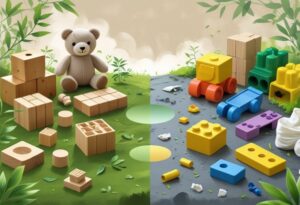Eco Friendly Toys Versus Plastic Toys: How to Save Money and Help the Planet

When shopping for toys, it’s easy to reach for cheap plastic options, but eco-friendly toys offer a strong alternative for both your wallet and the environment. By choosing toys made from sustainable materials, you can reduce your environmental impact and often end up saving money in the long term because these toys tend to last longer and don’t need frequent replacements. Recycled wood, organic fabrics, and natural dyes frequently found in eco-friendly toys are safer for children too.
Comparing the costs and benefits, the case for making the switch becomes clear. While the upfront cost can sometimes be higher, the overall savings and positive environmental effects make it a practical choice. For anyone wanting to save money and help the planet, there are straightforward ways to start shifting away from plastic toys.
Comparing Eco-Friendly Toys and Plastic Toys
Plastic toys can be lightweight and flexible, but cheaper plastics may snap, posing a choking hazard. Sharp edges or loose parts can sometimes result from breaks or manufacturing flaws.
Safety standards vary by country, but eco-friendly toymakers often use water-based paints and avoid small detachable parts. In contrast, not all plastic toys follow the same safety practices, making it important to check for CE markings or equivalent certifications.
Environmental Impact of Each Option
Opting for eco-friendly toys encourages a lower-waste lifestyle and reduces exposure to potentially harmful substances. The overall environmental savings can outweigh the sometimes higher initial cost.
Costs and Ways to Save Money

Plastic toys often appear cheaper initially, but eco-friendly alternatives can offer better value over time. Careful choices, smart shopping, and alternative options like second-hand purchases help me reduce costs while supporting sustainability.
Upfront Costs Versus Long-Term Value
When I buy plastic toys, the price tag is usually lower than comparable eco-friendly ones. Plastic options can be found for under £10, while many wooden or recycled-material toys often start at £15–£20. This cost gap is mainly due to material sourcing and manufacturing practices.
However, eco-friendly toys tend to last longer. They use durable woods, non-toxic paints, and quality joints. Many are designed for open-ended, multi-age use. I’ve found that a well-made wooden block set can endure years, even through multiple children, whereas cheap plastic toys may break or lose appeal quickly.
Cost Example Table:
| Toy Type | Average Initial Cost | Average Lifespan | Passed Down/Sold? |
| Plastic (new) | £8–£12 | 1–3 years | Rarely |
| Eco-friendly | £18–£35 | 5–10 years | Often |
Some money can be recovered by reselling good-quality eco toys.
Tips for Budget-Friendly Eco Toy Purchases
Look out for deals and sales, especially online. By signing up to mailing lists you sometimes receive discount codes from ethical retailers. Compare prices across different shops, and try to buy multi-functional toys that cover several play stages.
Here’s how to keep eco toy costs down:
- Buy off-season: I get bigger discounts just after Christmas or during back-to-school sales.
- Choose unbranded options: Lesser-known brands often use the same safe materials at a lower price.
- Look for bundles or sets: Buying packs instead of single items usually saves money per toy.
- Use cashback sites: Some retailers partner with cashback platforms, giving a partial refund after purchase.
Consider whether a toy will engage a child for years, which minimises the need for frequent replacements.
Second-Hand and Toy-Swapping Options
Shopping for second-hand toys saves money and reduces waste. Sites like eBay, Facebook Marketplace, and local charity shops offer pre-loved wooden toys at low prices, usually half or less than new. Check listings for photos of wear and make sure everything meets current safety standards before buying.
Toy-swapping events are another way to refresh a child’s toy box without spending more. Local parenting groups or community centres sometimes organise swaps. Outgrown or unused toys can be swapped for other quality items for free.
When buying second-hand or swapping, inspect toys for cracks, loose parts, or splinters. If needed, clean and sanitise items with simple, non-toxic cleaners before giving them to a child. This approach stretches your budget while supporting a circular, eco-conscious economy.
Environmental Benefits and Planet-Friendly Practices
Choosing ecofriendly toys instead of plastic ones helps lower environmental impact, reduces waste in landfill, and encourages a healthier lifestyle for children. I focus on how sustainable choices, responsible manufacturing, and teaching eco-friendly values can together create a real difference for the planet.
Reducing Waste Through Sustainable Choices
When I select toys made from natural materials like wood, organic cotton, or recycled resources, I actively reduce the amount of plastic ending up in landfill. Unlike standard plastic toys, which may take hundreds of years to decompose and can leach harmful chemicals, eco friendly options break down naturally or are fully recyclable.
Many eco toys are built to last, often outlasting their plastic counterparts. As a result, I find they are more likely to be handed down, donated, or even repurposed instead of discarded. By considering modular designs, toys with fewer mixed materials, and those free from single-use packaging, I can further limit unnecessary waste.
| Type of Toy | Lifespan | End-of-Life Options |
| Plastic (standard) | 1-5 years | Landfill, low recyclability |
| Wooden (sustainable) | 10+ years | Compost, reuse, recycle |
| Fabric (organic) | 5+ years | Compost, upcycle |

Supporting Responsible Manufacturers
Here, at Planet Apple Toys, we prioritise brands that embrace ethical sourcing and transparency in their production process. Companies adopting fair labour, using certified sustainable materials, or maintaining carbon-neutral shipping have a positive effect beyond just the toy itself.
When we check for third-party certifications, such as FSC (Forest Stewardship Council), GOTS (Global Organic Textile Standard), or OEKO-TEX, we ensure that toys meet strict environmental and social criteria. Some manufacturers go even further, choosing minimal packaging or operating take-back schemes to recycle old toys.
Supporting these practices not only lowers the environmental footprint but also pushes the industry towards greener standards. It often means the toy is safer and higher quality, both in terms of design and materials.
Teaching Eco-Conscious Habits to Children
By involving children in choosing and caring for ecofriendly toys, it helps develop their understanding of sustainability. Recycling, sharing, or repairing toys matters, and encourages participation in these activities from an early age.
Try simple activities like making homemade toys from recycled materials or donating unused toys to local charities. This promotes resourcefulness and reduces the desire for frequent new purchases.
These habits help children value longevity and responsible consumption. When children learn to care for their belongings and understand their environmental impact, it leads to more mindful decision making throughout their lives.




 01458 258189
01458 258189